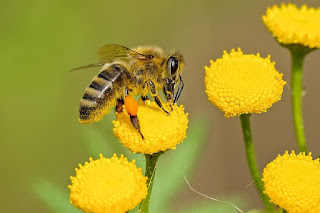Types of Pollination
-
Self-Pollination:
- Occurs when pollen from the same flower or plant reaches the stigma of the same plant.
- Common in plants like tomatoes and peas.
- Benefits: No need for external agents (like insects or wind), ensuring that pollination still occurs even in isolated conditions.
-
Cross-Pollination:
- Pollen is transferred from one flower to the stigma of another flower (of the same species) on a different plant.
- Cross-pollination is necessary for many plant species to maintain genetic diversity.
- Often facilitated by pollinators such as insects, birds, wind, or water.
Pollinators
-
Insects:
- The most common pollinators, particularly bees, butterflies, moths, and beetles.
- Bees (e.g., honeybees, bumblebees) are the most effective pollinators due to their hairy bodies, which trap pollen as they move from flower to flower.
- Butterflies and moths typically pollinate flowers during the day and night, respectively.
-
Birds:
- Birds like hummingbirds are important pollinators, especially in tropical regions.
- They feed on nectar and help pollinate flowers with long tubular shapes that are adapted to their beaks.
-
Wind:
- Many trees and grasses, such as corn and wheat, rely on the wind for pollination.
- The wind carries lightweight pollen from male flowers to female flowers.
-
Bats:In some regions, especially in tropical climates, bats are important pollinators for nocturnal plants like agave and some species of cacti.
-
Water:Less common, but some aquatic plants rely on water for pollination.
The Process of Pollination
- Pollen Transfer:
- Pollinators visit flowers to collect nectar (their food source) or pollen. As they do, they brush against the anthers and pick up pollen.
- The pollinator then moves to another flower, transferring pollen to the stigma, which is the receptive part of the female reproductive organ.
- Fertilization:
- After pollen reaches the stigma, it travels down to the ovary where fertilization occurs, leading to seed and fruit production.
- For many plants, successful pollination results in the development of seeds, which grow into new plants.
Importance of Pollination
-
Food Production:
- Pollination is essential for the production of fruits, vegetables, nuts, and seeds. Around 75% of flowering plants and 35% of food crops depend on animal pollinators.
- Key crops affected include apples, almonds, coffee, cucumbers, berries, and more.
-
Biodiversity:Pollination supports the reproduction of a vast array of plants, which in turn supports the entire food web, providing habitat and food for countless species of animals.
-
Ecological Balance:Pollination helps maintain healthy ecosystems by ensuring the continued reproduction of plant species, many of which form the foundation of various habitats.
Threats to Pollination
-
Habitat Loss:Urbanization, agricultural expansion, and deforestation lead to the destruction of natural habitats, reducing the available food and nesting sites for pollinators.
-
Pesticides:The use of harmful chemicals in agriculture can harm pollinators, particularly bees, leading to colony collapse and reduced pollination rates.
-
Climate Change:Shifts in temperature and weather patterns can alter the timing of flowering and the availability of pollinators, leading to mismatches between when plants bloom and when pollinators are active.
-
Monoculture Farming:Large-scale monoculture farming (growing only one crop) can reduce biodiversity and make it harder for pollinators to find food sources and habitats.
Conservation and Support for Pollinators
-
Planting Pollinator-Friendly Plants:Grow a variety of flowers, shrubs, and trees that provide nectar and pollen throughout the year.
-
Reducing Pesticide Use:Use eco-friendly and pollinator-safe pesticides or opt for integrated pest management (IPM) to reduce harm to pollinators.
-
Creating Pollinator Habitats:Protect and restore natural habitats like wildflower meadows, hedgerows, and forests where pollinators can thrive.
-
Supporting Beekeeping and Pollinator Farms:Encourage beekeeping for the conservation of bees, as well as the establishment of pollinator farms for habitat restoration.
-
Raising Awareness:Support initiatives aimed at educating the public about the importance of pollinators and their role in the environment.











Hiç yorum yok:
Yorum Gönder
Yorumunuz İçin Teşekkürler